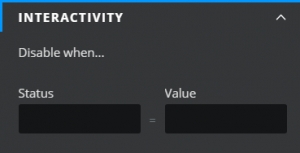Screenshot
This article describes the Screenshot component and its properties.
Clicking a Screenshot in a project the user to save a screenshot of the current view of the project.
Select Screenshot from the controls category of the component library. Move the mouse over the canvas and click to add a Screenshot button to your project:

Screenshot Properties
The Screenshot properties consist of BUTTON STYLING, INTERACTIVITY, and DYNAMIC VISIBILITY drawers. This guide will describe the data insertion, button styling, and interactivity properties only; the dynamic visibility properties are generic to each component and a separate guide and tutorial on dynamic visibility can be found here.
BUTTON STYLING
The button styling section allows the designer to change the style of the button, the filename the screenshot is saved as, and the type of image file generated.

Filename – This property determines the name of the local file containing the screenshot which is saved on the user’s machine.
File type – This property determines whether the file is saved as a “png” or “jpeg” file format.
DEFAULT STYLE
In this section, you can set the color, border, and drop shadow properties of the button.

Icon color – this determines the color of the camera icon in the button, to hide the icon set this color to the same as the background
Fill – When checked, the background of the button will be filled with a color that matches the value entered in the property field.
Opacity – This determines the transparency of the background of the text label. This is only available when the Fill checkbox is checked.
Border – This property is unchecked by default. Check to add a border to the button and set the border color and opacity properties as desired.
Weight – This property determines the line thickness of the button border in pixels.
Individual Weight - selected this property to apply different widths to each of the component's borders. Each of these individual inputs can be manually edited or bound to the spreadsheet.
Line style – Select a borderline style from the dropdown box. The options are solid and dashed:

Corners – This property determines the corner radius of the button border. Use the slider to amend this property, or type a numerical value into the property field.
Individual Corners - selected this property to apply different radii to each of the component's corners. Each of these individual inputs can be manually edited or bound to the spreadsheet.
Effects – Choose between None and Drop Shadow from the dropdown box. If Drop Shadow is selected, further drop shadow properties are shown.
HOVER STATE
The HOVER STATE property is checked by default. Uncheck this if you wish to disable the hover state properties.

Hover Text Color – As the mouse moves over the button, the button label text will change to the color value entered in this property field.
Opacity – As the mouse moves over the button, the opacity of the button label text will change to the value entered in this property field.
Hover Fill – As the mouse moves over the button, the button background color will change to the color value entered in this property field.
Opacity – As the mouse moves over the button, the opacity of the button will change to the value entered in this property field.
PRESSED STATE
The PRESSED STATE property is checked by default. Uncheck this if you wish to disable the pressed state properties.

Pressed Text Color – As the button is clicked, its label text will change to the color value entered in this property field.
Opacity – As the button is clicked, the opacity of its label text will change to the value entered in this property field.
Hover Fill – As the button is clicked, its background color will change to the color value entered in this property field.
Opacity – As the button is clicked, its opacity will change to the value entered in this property field.
INTERACTIVITY
It is possible to disable the button:

Last updated
Was this helpful?